Remote Sensing-Based Land Suitability Analysis for Forest Restoration in Madagascar
Abstract
:1. Introduction
2. Materials and Methods
2.1. The Study Area
2.2. The Suitability Analysis
- (1)
- identification of a set of restoration criteria
- (2)
- acquisition of available GIS datasets for each criterion
- (3)
- generating suitability maps for each criterion
- (4)
- conception of a suitability analysis model
- (5)
- design of potential sites for restoration.
2.2.1. Identification of Criteria for Land Suitability Analysis
- Land cover class- The land cover classes of interest include seven categories which are: dense forest (primary forest and mangroves), degraded forest (degraded continuous forest and forest fragments), grassland (nonwoody vegetation such as grasses, herbaceous plants), agriculture areas (mostly rice field, commercial crops, tannes. The term ‘tannes’ refers to the inner part of mangroves, coastal wetlands found in tropical and subtropical regions. They represent the least frequently submerged zones, with soils generally oversalted or acidified, developing at the expense of a mangrove. We distinguish between “naked tannes” and “herbaceous tannes” according to the vegetation cover in mangrove areas, agroforestry), and minor land cover classes such as waterbody (river, lake, stream), bare land, and limestone massif (classified as rock). Forests (dense and degraded) and grassland were given priority in our criteria to assess the Ecological factor (Figure 2a).
- Distance from protected sites and forest patches—Restoration in and around a protected site and forest patches means both enhancing the forested ecosystem and creating a buffer zone that prevents the site from being disturbed. In addition, areas around existing forests are a priority for their proximity to reservoirs of native species [28]. The location of protected sites and forest cover in the watershed region are shown in Figure 2b.
- Settlements—Settlements include human habitation and build infrastructures (hospitals, schools, churches and sports areas). High concentration of human activities in cities and villages are considered a driver for land degradation and natural resources exploitation in the nearby forest area. In a study of deforestation in the northeast part of the country [11], it was proposed that the range of influence of land users is at a maximum of about 2.5 km from the home village, which can be extrapolated to about 20 km2 neighborhood area from the village. A settlement map is produced using Landsat 8 OLI satellite images and verified with Google Earth map (Figure 2c).
- Risk of soil erosion—To achieve restoration objectives in a watershed, soil loss due to erosion is an important criterion to consider in choosing priority areas for restoration. Preventing and stabilizing erosion-prone land by increasing the vegetation cover is among the main objectives of restoration activities in a watershed [28]. A soil erosion map is produced using a method called Revised Universal Soil Loss Equation (RUSLE), explained in Section 2.2.3—Soil Erosion Map.
2.2.2. Data Acquisition and Sources
2.2.3. Map Generation for Each Criterion
Image Processing for Land Use/Land Cover (LULC)
Accuracy Assessment for LULC Classification Map
Soil Erosion Map
- A = the average annual soil loss (ton ha−1 yr−1)
- R = the rainfall-runoff erosivity factor (MJ mm ha−1 hr−1 yr−1)
- K = soil erodibility factor (ton ha hr MJ−1 ha−1 mm−1)
- LS = topographic steepness factor (based on length and slope)
- C = land cover management factor
- P = erosion-control practices factor
| Factor | Estimation of Factor | Description | Source | |
|---|---|---|---|---|
| R | (3) | It quantifies the amount of runoff associated with the rain and was computed using global rainfall information from the Climatic Research Unit Database, based on 10-year average rainfall record (2011–2021). | [55] | |
where:
| ||||
| K | (4) | It represents the susceptibility of soil to erosion depending on soil properties, rainfall, and runoff. Global Soil Data from the FAO Database was used to process K factor. | [56] | |
where:
| ||||
| LS | (5) | It reflects the influence of topography on soil loss and computed using elevation data. | [57] | |
where:
| ||||
| C, P | Refer to Table 3 | C factor denotes the rate of soil loss associated with a land use class and management practices and calculated using land cover classification of the study area from the classified satellite data. P factor reflects the rate of soil loss associated with support conservation practices such as contour farming, strip cropping, and terracing. | [52,58] | |
2.2.4. Conception of the Land Suitability Analysis Model
- Reclassification of each criterion map: Once the five maps are generated, they are combined using a multicriteria analysis to generate the final suitability map. However, to make them comparable before the computation, a reclassification process was performed. Reclassification of the selected criteria is performed to better understand the importance of each criterion in the suitability assessment. It consists of replacing a new value in each criterion map to reclassify the vector and raster data [6,28]. The reclassification is based on the following levels of suitability: highly suitable (S1), moderately suitable (S2), marginally suitable (S3) and not suitable (N) (Table 4).
- Distance from protected areas and forest patches: The ranking system was based on natural forest regeneration through seed dispersal limitations Natural regeneration is highly favored in areas within an 100 m radius via short-distance dispersal (e.g., wind, gravity) [61,62] and still be possible via longer-distance dispersal within 100–1000 m (e.g., birds, bats, primates) [62].
- Soil loss priority and severity ranking: This was based on soil loss potential of the Abay river basin in Ethiopia, Africa, in which catastrophic soil loss is classified as greater than 500 t ha−1 yr−1, severe is between 50 to 500 t ha−1 yr−1, and less than 50 t ha−1 yr−1 is moderate to slight soil loss [61].
| Suitability Class | |||||
|---|---|---|---|---|---|
| Criteria | Highly Suitable (S1) | Moderately Suitable (S2) | Marginally Suitable (S3) | Not Suitable (N) | Literature |
|
Distance from protected areas and forest patches (m) | <100 | 100–500 | 500–1000 | >1000 | [61,62] |
| LULC | Forest (dense and degraded) | Grassland | Agriculture land, Bare land | Water, Rock | [6] |
| Soil loss (t ha−1 yr−1) | >500 | 50–500 | 0–50 | [63] | |
| Distance from settlements (m) | >2500 | 2000–2500 | 1500–2000 | <1500 | [7,11] |
| Distance from roads (m) | >500 | 250–500 | 50–250 | <50 | [63] |
- Distance from settlements: we based the rank on the assessment made by [11] in north-eastern Madagascar, in which they conclude the range of influence of land users within a radius of about 2.5 km from the home village. We therefore set the distance of the most suitable areas to greater than 2500 m from settlements. However, we considered, at our own discretion, the radius within 1500–2500 m as moderately and marginally suitable because of some restoration activities such as agroforestry that local people usually practice around their villages [7,11].
- Distance from roads: the suitability class for distance from roads was estimated from a buffer analysis, based on previous urban development studies [64], and the influence of human disturbance from road infrastructures. Based on buffer analysis, the spatial agglomeration impacts of road infrastructures in the region are within 500 m in large cities and within 50 m in rural areas. Therefore, we set a margin value between 50 to 500 m as the basic buffer value.
- Designing Options for Priority Restoration Sites: The basic assumption that guided the process of land suitability is that a site can be restored only if it is sufficiently within or around forests and nature reserves; not in close proximity to agriculture, roads and settlements; and in erosion-prone land areas [28]. In other words, the most suitable site to be restored is that minimizing landscape fragmentation (distance from protected areas and forest patches, LULC), minimizing conflicts with human settlements, infrastructures, and agricultural fields (distance from settlements and roads, LULC), minimize soil erosion (soil loss). The rationale for this assumption was that restoring erosion-prone lands within a watershed with potential agricultural outcomes is likely to improve provision of ecosystem services, in particular water and soil quality, precisely where people are most exposed to land degradation, as in many rural areas in the Mahavavy region. For this reason, criteria related to distance from protected areas and forest patches, LULC, and soil loss were considered benefits, while criteria related to distance from settlements and distance from roads were considered costs.
3. Results
3.1. Soil Quantification and Mapping
3.2. Accuracy Assessment for LULC Classification
3.3. Land Suitability Analysis for Priority Restoration Areas
3.3.1. Reclassification of Criteria
3.3.2. Land Suitability Analysis
4. Discussion
5. Conclusions
Author Contributions
Funding
Data Availability Statement
Acknowledgments
Conflicts of Interest
References
- Laurance, W.F.; Sayer, J.; Cassman, K.G. Agricultural expansion and its impacts on tropical nature. Trends Ecol. Evol. 2014, 29, 107–116. [Google Scholar] [CrossRef] [PubMed]
- Newbold, T.; Hudson, L.N.; Phillips, H.R.P.; Hill, S.L.L.; Contu, S.; Lysenko, I.; Blandon, A.; Butchart, S.H.M.; Booth, H.L.; Day, J.; et al. A global model of the response of tropical and sub-tropical forest biodiversity to anthropogenic pressures. Proc. R. Soc. B Biol. Sci. 2014, 281, 20141371. [Google Scholar] [CrossRef] [PubMed] [Green Version]
- Sánchez-Cuervo, A.M.; de Lima, L.S.; Dallmeier, F.; Garate, P.; Bravo, A.; Vanthomme, H. Twenty years of land cover change in the southeastern Peruvian Amazon: Implications for biodiversity conservation. Reg. Environ. Chang. 2020, 20, 8. [Google Scholar] [CrossRef]
- Sodhi, N.S. Tropical biodiversity loss and people—A brief review. Basic Appl. Ecol. 2008, 9, 93–99. [Google Scholar] [CrossRef]
- Zeng, Z.; Estes, L.; Ziegler, A.D.; Chen, A.; Searchinger, T.; Hua, F.; Guan, K.; Jintrawet, A.; Wood, E.F. Highland cropland expansion and forest loss in Southeast Asia in the twenty-first century. Nat. Geosci. 2018, 11, 556–562. [Google Scholar] [CrossRef]
- Nurda, N.; Noguchi, R.; Ahamed, T. Change Detection and Land Suitability Analysis for Extension of Potential Forest Areas in Indonesia Using Satellite Remote Sensing and GIS. Forests 2020, 11, 398. [Google Scholar] [CrossRef] [Green Version]
- Zaehringer, J.G.; Eckert, S.; Messerli, P. Revealing Regional Deforestation Dynamics in North-Eastern Madagascar—Insights from Multi-Temporal Land Cover Change Analysis. Land 2015, 4, 454–474. [Google Scholar] [CrossRef] [Green Version]
- Brinkmann, K.; Noromiarilanto, F.; Ratovonamana, R.Y.; Buerkert, A. Deforestation processes in south-western Madagascar over the past 40 years: What can we learn from settlement characteristics? Agric. Ecosyst. Environ. 2014, 195, 231–243. [Google Scholar] [CrossRef]
- Grinand, C.; Rakotomalala, F.; Gond, V.; Vaudry, R.; Bernoux, M.; Vieilledent, G. Estimating deforestation in tropical humid and dry forests in Madagascar from 2000 to 2010 using multi-date Landsat satellite images and the random forests classifier. Remote Sens. Environ. 2013, 139, 68–80. [Google Scholar] [CrossRef]
- Harper, G.J.; Steininger, M.K.; Tucker, C.J.; Juhn, D.; Hawkins, F. Fifty years of deforestation and forest fragmentation in Madagascar. Environ. Conserv. 2007, 34, 325–333. [Google Scholar] [CrossRef]
- Zaehringer, J.G.; Hett, C.; Ramamonjisoa, B.; Messerli, P. Beyond deforestation monitoring in conservation hotspots: Analysing landscape mosaic dynamics in north-eastern Madagascar. Appl. Geogr. 2016, 68, 9–19. [Google Scholar] [CrossRef] [Green Version]
- Carrasco, J.; Price, V.; Tulloch, V.; Mills, M. Selecting priority areas for the conservation of endemic trees species and their ecosystems in Madagascar considering both conservation value and vulnerability to human pressure. Biodivers. Conserv. 2020, 29, 1841–1854. [Google Scholar] [CrossRef]
- Clubbe, C.; Cable, S.; Ralimanana, H. Madagascar: A Biodiversity Hotspot Still Revealing Its Botanical Treasures. Curtis’s Bot. Mag. 2020, 37, 250–259. [Google Scholar] [CrossRef]
- Myers, N.; Mittermeier, R.A.; Mittermeier, C.G.; da Fonseca, G.A.B.; Kent, J. Biodiversity hotspots for conservation priorities. Nature 2000, 403, 853–858. [Google Scholar] [CrossRef] [PubMed]
- Bayart, F.; Simmen, B. Demography, range use, and behavior in black lemurs (Eulemur macaco macaco) at Ampasikely, northwest Madagascar. Am. J. Primatol. 2005, 67, 299–312. [Google Scholar] [CrossRef] [PubMed]
- Goodman, S.M.; Benstead, J.P. Updated estimates of biotic diversity and endemism for Madagascar. Oryx 2005, 39, 73–77. [Google Scholar] [CrossRef] [Green Version]
- Phillipson, P.; Schatz, G.; Lowry, P., II; Labat, J.N. Catalogue of the Vascular Plants of Madagascar; Royal Botanic Gardens, Kew: London, UK, 2006; pp. 613–627. [Google Scholar]
- Llopis, J.C.; Harimalala, P.C.; Bär, R.; Heinimann, A.; Rabemananjara, Z.H.; Zaehringer, J.G. Effects of protected area establishment and cash crop price dynamics on land use transitions 1990–2017 in north-eastern Madagascar. J. Land Use Sci. 2019, 14, 52–80. [Google Scholar] [CrossRef]
- Manjaribe, C.; Frasier, C.L.; Rakouth, B.; Louis, E.E. Ecological restoration and reforestation of fragmented forests in Kianjavato, Madagascar. Int. J. Ecol. 2013, 2013, 726275. [Google Scholar] [CrossRef] [Green Version]
- Zaehringer, J.G.; Llopis, J.C.; Latthachack, P.; Thein, T.T.; Heinimann, A. A novel participatory and remote-sensing-based approach to mapping annual land use change on forest frontiers in Laos, Myanmar, and Madagascar. J. Land Use Sci. 2018, 13, 16–31. [Google Scholar] [CrossRef] [Green Version]
- Maginnis, S.; Rietbergen-McCracken, J.; Sarre, A. The Forest Landscape Restoration Handbook; Routledge: London, UK, 2012. [Google Scholar]
- Sabogal, C.; Besacier, C.; McGuire, D. Forest and landscape restoration: Concepts, approaches and challenges for implementation. Unasylva 2015, 66, 3–10. [Google Scholar]
- Castillo-Mandujano, J.; Smith-Ramírez, C. The need for holistic approach in the identification of priority areas to restore: A review. Restor. Ecol. 2022, e13637. [Google Scholar] [CrossRef]
- Mansourian, S.; Dudley, N.; Vallauri, D. Forest Landscape Restoration: Progress in the Last Decade and Remaining Challenges. Ecol. Restor. 2017, 35, 281–288. [Google Scholar] [CrossRef]
- Newton, A.C. Principles and Practice of Forest Landscape Restoration: Case Studies from the Drylands of Latin America; IUCN: Gland, Switzerland, 2011. [Google Scholar]
- WWF; IUCN. Minutes of the Forests Reborn Workshop in Segovia. Segovia, Spain, Unpublished. 2000. Available online: https://docslib.org/doc/1764686/forests-reborn-a-workshop-on-forest-restoration (accessed on 20 May 2022).
- Maginnis, S.; Jackson, W. Restoring forest landscapes. ITTO Trop. For. Update 2002, 12, 9–11. [Google Scholar]
- Orsi, F.; Geneletti, D. Identifying priority areas for Forest Landscape Restoration in Chiapas (Mexico): An operational approach combining ecological and socioeconomic criteria. Landsc. Urban Plan. 2010, 94, 20–30. [Google Scholar] [CrossRef]
- Mansourian, S.; Vallauri, D. Restoring forest landscapes: Important lessons learnt. Environ. Manag. 2014, 53, 241–251. [Google Scholar] [CrossRef] [PubMed]
- Vogler, K.C.; Ager, A.A.; Day, M.A.; Jennings, M.; Bailey, J.D. Prioritization of Forest Restoration Projects: Tradeoffs between Wildfire Protection, Ecological Restoration and Economic Objectives. Forests 2015, 6, 4403–4420. [Google Scholar] [CrossRef] [Green Version]
- Cipollini, K.A.; Maruyama, A.L.; Zimmerman, C.L. Planning for Restoration: A Decision Analysis Approach to Prioritization. Restor. Ecol. 2005, 13, 460–470. [Google Scholar] [CrossRef]
- Eastman, R. Multi-criteria evaluation and GIS. In Geographical Information Systems, Chap 35; Longley, P.A., Goodchild, M.F., Maguire, D.J., Rhind, D.W., Eds.; Wiley: New York, NY, USA, 1999; pp. 493–502. [Google Scholar]
- Malczewski, J. GIS-based multicriteria decision analysis: A survey of the literature. Int. J. Geogr. Inf. Sci. 2006, 20, 703–726. [Google Scholar] [CrossRef]
- Pereira, J.M.C.; Duckstein, L. A multiple criteria decision-making approach to GIS-based land suitability evaluation. Int. J. Geogr. Inf. Syst. 1993, 7, 407–424. [Google Scholar] [CrossRef]
- Store, R.; Kangas, J. Integrating spatial multi-criteria evaluation and expert knowledge for GIS-based habitat suitability modelling. Landsc. Urban Plan. 2001, 55, 79–93. [Google Scholar] [CrossRef]
- Thinh, N.X.; Walz, U.; Schanze, J.; Ferencsik, I.; Göncz, A. GIS-based multiple criteria decision analysis and optimization for land suitability evaluation. In Simulation in Umwelt– und Geowissenschaften; Wittmann, J., Wieland, R., Eds.; Shaker: Aachen, Germany, 2004; pp. 208–223. [Google Scholar]
- Uribe, D.; Geneletti, D.; Del Castillo, R.F.; Orsi, F. Integrating Stakeholder Preferences and GIS-Based Multicriteria Analysis to Identify Forest Landscape Restoration Priorities. Sustainability 2014, 6, 935–951. [Google Scholar] [CrossRef] [Green Version]
- Tzioutzios, C.; Kastridis, A. Multi-criteria evaluation (MCE) method for the management of woodland plantations in floodplain areas. ISPRS Int. J. Geo-Inf. 2020, 9, 725. [Google Scholar] [CrossRef]
- Van der Horst, D.; Gimona, A. Where new farm woodlands support biodiversity action plans: A spatial multi-criteria analysis. Biol. Conserv. 2005, 123, 421–432. [Google Scholar] [CrossRef]
- MEDD Madagascar. Stratégie Nationale sur la Restauration des Paysages Forestiers et des Infrastructures Vertes à Mad-Agascar. FAO. 2017. Available online: https://www.fao.org/faolex/results/details/es/c/LEX-FAOC176034/ (accessed on 18 May 2022).
- McClain, S.N.; McMullen, C.P.; Abiodun, B.J.; Armiento, G.; Bailey, R.; Balasubramanian, R.; Barra, R.; Bowen, K.J.; Dankelman, I.; DePryck, K.; et al. Cross-Cutting Issues-Global Environment Outlook (GEO-6): Healthy Planet, Healthy People Chapter 4. In Global Environment Outlook (GEO-6): Healthy Planet, Healthy People; UN Environment, Cambridge University Press: Cambridge, UK, 2019; pp. 77–104. [Google Scholar]
- Rasolofoarivao, H.; Ravaomanarivo, L.H.R.; Delatte, H. Host plant ranges of fruit flies (Diptera: Tephritidae) in Madagascar. Bull. Èntomol. Res. 2022, 112, 1–12. [Google Scholar] [CrossRef] [PubMed]
- Zaehringer, J.G.; Schwilch, G.; Andriamihaja, O.R.; Ramamonjisoa, B.; Messerli, P. Remote sensing combined with social-ecological data: The importance of diverse land uses for ecosystem service provision in north-eastern Madagascar. Ecosyst. Serv. 2017, 25, 140–152. [Google Scholar] [CrossRef] [Green Version]
- Luan, C.; Liu, R.; Peng, S. Land-use suitability assessment for urban development using a GIS-based soft computing approach: A case study of Ili Valley, China. Ecol. Indic. 2021, 123, 107333. [Google Scholar] [CrossRef]
- Ahmadi Sani, N.; Babaie Kafaky, S.; Pukkala, T.; Mataji, A. Integrated use of GIS, remote sensing and multi-criteria decision analysis to assess ecological land suitability in multi-functional forestry. J. For. Res. 2016, 27, 1127–1135. [Google Scholar] [CrossRef]
- Bojórquez-Tapia, L.; Díaz-Mondragón, S.; Gómez-Priego, P. GIS-approach for land suitability assessment in developing countries: A case study of forest development project in Mexico. In Spatial Multicriteria Decision Making and Analysis; A Geographic Information Sciences Approach; Thill, J.C., Ed.; Taylor & Francis Group: Abingdon, UK, 1999; pp. 335–352. [Google Scholar]
- Chanhda, H.; Wu, C.; Ye, Y.; Ayumi, Y. GIS based land suitability assessment along Laos- China border. J. For. Res. 2010, 21, 343–349. [Google Scholar] [CrossRef]
- García-Álvarez, D.; Lara Hinojosa, J. General Land Use Cover Datasets for Africa. In Land Use Cover Datasets and Validation Tools: Validation Practices with QGIS; García-Álvarez, D., Olmedo, M.T.C., Paegelow, M., Mas, J.F., Eds.; Springer International Publishing: Cham, Switzerland, 2022; pp. 347–360. [Google Scholar] [CrossRef]
- Di Gregorio, A.; Jansen, L. Land Cover Classification System, Classification Concepts and User Manual; Food and Agriculture Organization of the United Nations: Rome, Italy, 2000. [Google Scholar]
- Martin-Mikle, C.J.; de Beurs, K.M.; Julian, J.P.; Mayer, P.M. Identifying priority sites for low impact development (LID) in a mixed-use watershed. Landsc. Urban Plan. 2015, 140, 29–41. [Google Scholar] [CrossRef] [Green Version]
- Bahadur, K.C.K. Mapping soil erosion susceptibility using remote sensing and GIS: A case of the Upper Nam Wa Watershed, Nan Province, Thailand. Environ. Geol. 2009, 57, 695–705. [Google Scholar] [CrossRef]
- Swarnkar, S.; Malini, A.; Tripathi, S.; Sinha, R. Assessment of uncertainties in soil erosion and sediment yield estimates at ungauged basins: An application to the Garra River basin, India. Hydrol. Earth Syst. Sci. 2018, 22, 2471–2485. [Google Scholar] [CrossRef]
- Kastridis, A.; Stathis, D.; Sapountzis, M.; Theodosiou, G. Insect Outbreak and Long-Term Post-Fire Effects on Soil Erosion in Mediterranean Suburban Forest. Land 2022, 11, 911. [Google Scholar] [CrossRef]
- Ferreira, C.S.S.; Seifollahi-Aghmiuni, S.; Destouni, G.; Ghajarnia, N.; Kalantari, Z. Soil degradation in the European Mediterranean region: Processes, status and consequences. Sci. Total Environ. 2022, 805, 150106. [Google Scholar] [CrossRef] [PubMed]
- Wischmeier, W.H.; Smith, D.D. Predicting rainfall erosion losses—A guide to conservation planning. In Agriculture Handbook No. 282; US Department of Agriculture: Washington, DC, USA, 1978. [Google Scholar]
- Williams, J.R. The EPIC model. In Computer Models of Watershed Hydrology; Singh, V.P., Ed.; Water Resources Publisher: Colorado, CO, USA, 1995; pp. 909–1000. [Google Scholar]
- Moore, I.D.; Burch, G.J. Modelling erosion and deposition: Topographic effects. Trans. ASAE 1986, 29, 1624–1640. [Google Scholar] [CrossRef]
- Kolli, M.; Opp, C.; Groll, M. Estimation of soil erosion and sediment yield concentration across the Kolleru Lake catchment using GIS. Environ. Earth Sci. 2021, 80, 161. [Google Scholar] [CrossRef]
- Van Oosten, C. Forest landscape restoration: Who decides? A governance approach to forest landscape restoration. Nat. Conserv. 2013, 11, 119–126. [Google Scholar] [CrossRef]
- Duguma, T.A. Soil erosion risk assessment and treatment priority classification: A case study on guder watersheds, Abay river basin, Oromia, Ethiopia. Heliyon 2022, 8, e10183. [Google Scholar] [CrossRef]
- Molin, P.G.; Chazdon, R.; Ferraz, S.F.D.B.; Brancalion, P.H.S. A landscape approach for cost-effective large-scale forest restoration. J. Appl. Ecol. 2018, 55, 2767–2778. [Google Scholar] [CrossRef]
- Reid, J.L.; Holl, K.D.; Zahawi, R.A. Seed dispersal limitations shift over time in tropical forest restoration. Ecol. Appl. 2015, 25, 1072–1082. [Google Scholar] [CrossRef] [Green Version]
- Lamb, D.; Stanturf, J.; Madsen, P. What is forest landscape restoration? In Forest Landscape Restoration: Integrating Natural and Social Sciences; Stanturf, J., Lamb, D., Madsen, P., Eds.; Springer: Dordrecht, The Netherlands, 2012; pp. 3–23. [Google Scholar] [CrossRef]
- Rietbergen-McCracken, J.; Maginnis, S.; Alastair, S. The Forest Landscape Restoration Handbook; The Earthscan Forestry Library Series; Taylor & Francis Group: Abingdon, UK, 2007. [Google Scholar]
- Ceballos-Silva, A.; Lopez-Blanco, J. Delineation of suitable areas for crops using a multi-criteria evaluation approach and land use/cover mapping: A case study in Central Mexico. Agric. Syst. 2003, 77, 117–136. [Google Scholar] [CrossRef]
- Vettorazzi, C.A.; Valente, R.A. Priority areas for forest restoration aiming at the conservation of water resources. Ecol. Eng. 2016, 94, 255–267. [Google Scholar] [CrossRef]
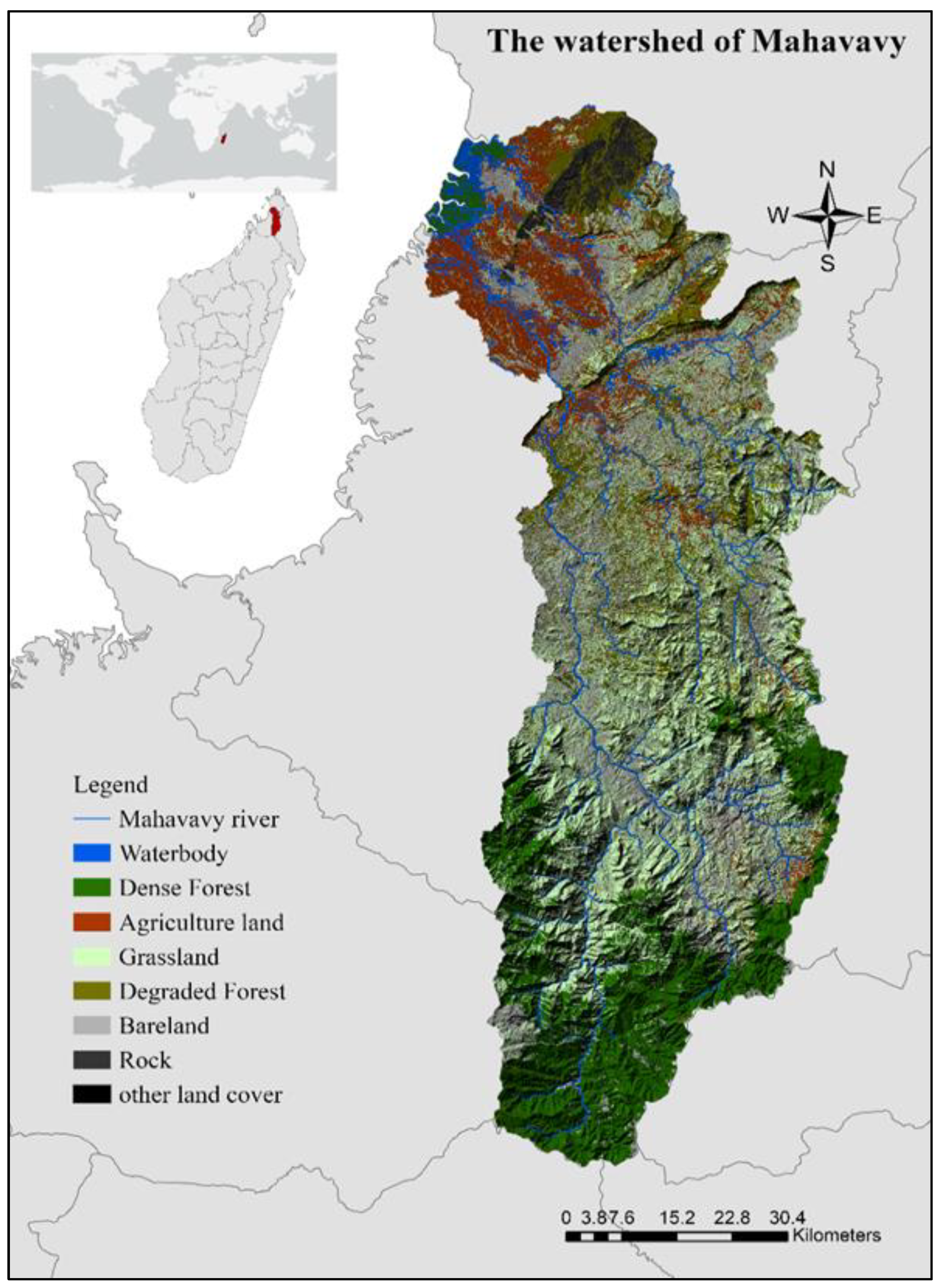
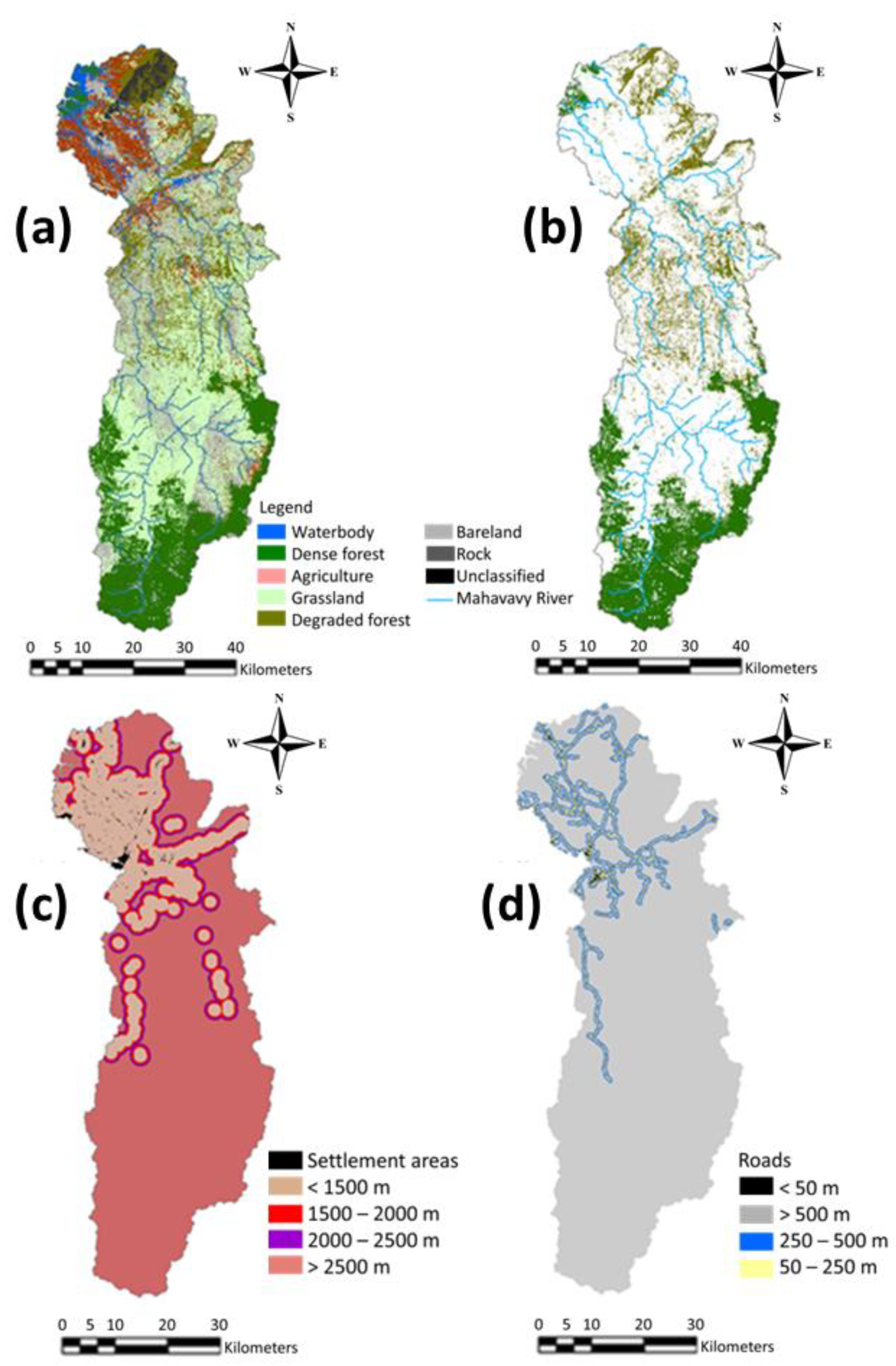
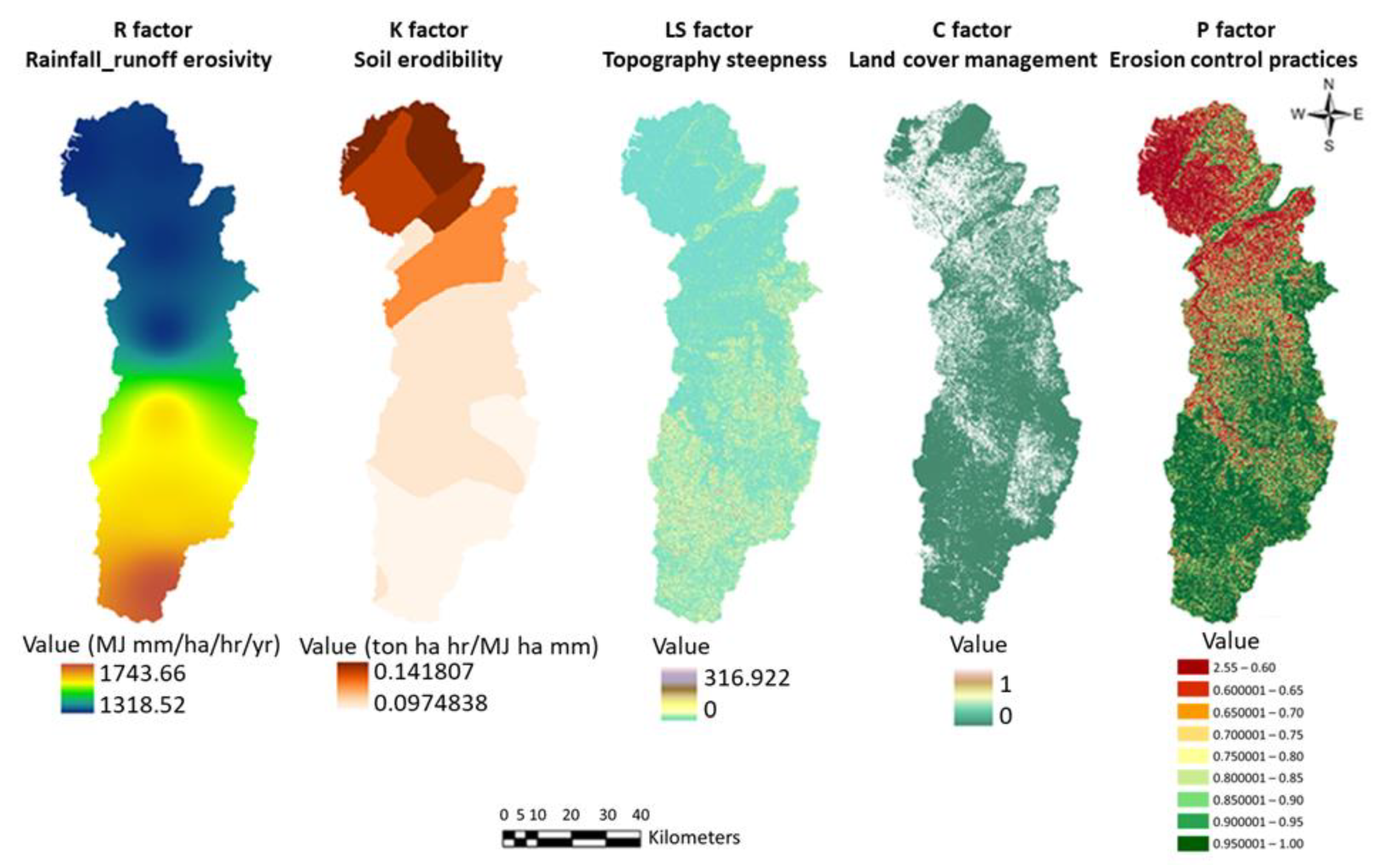
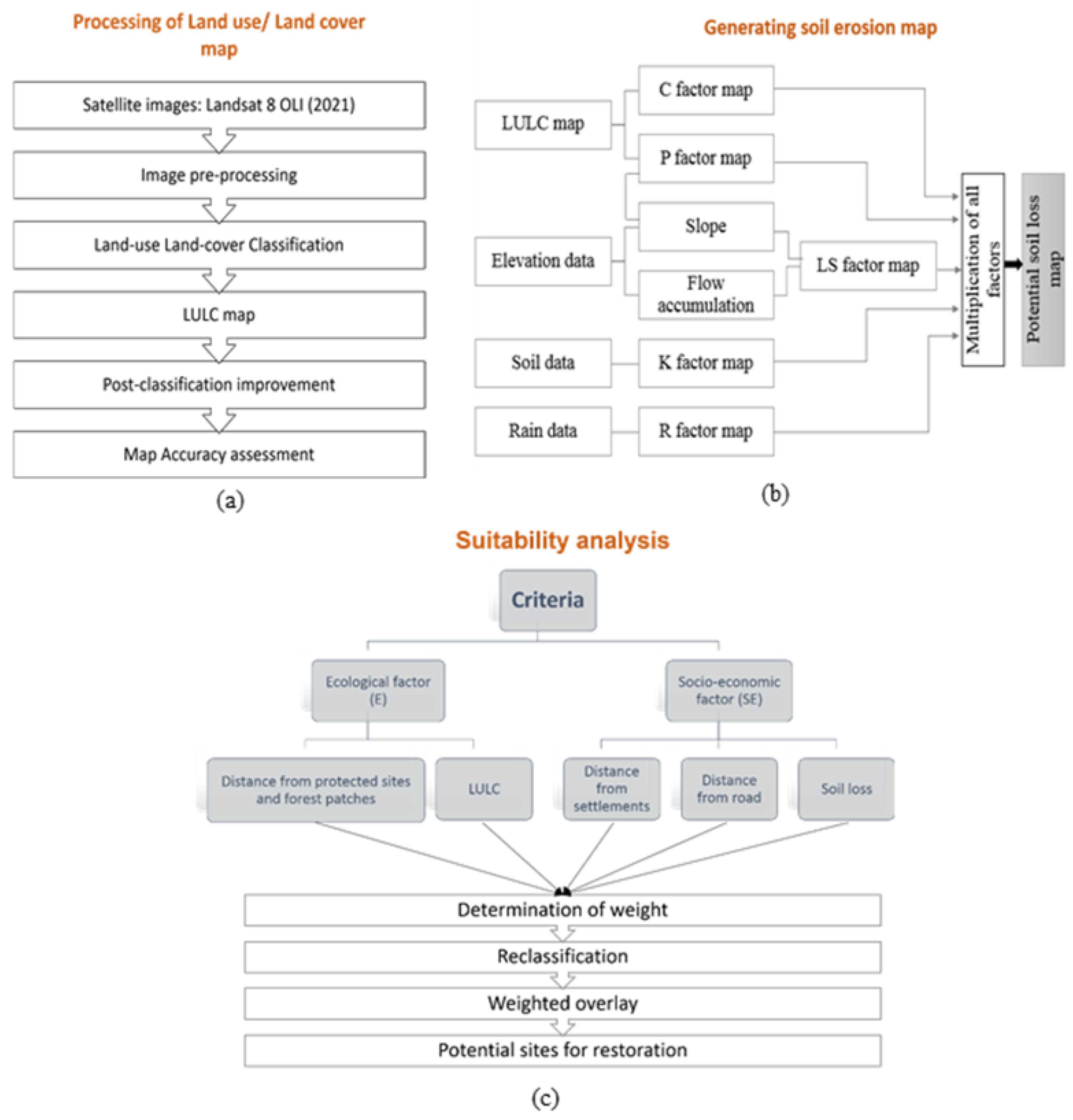
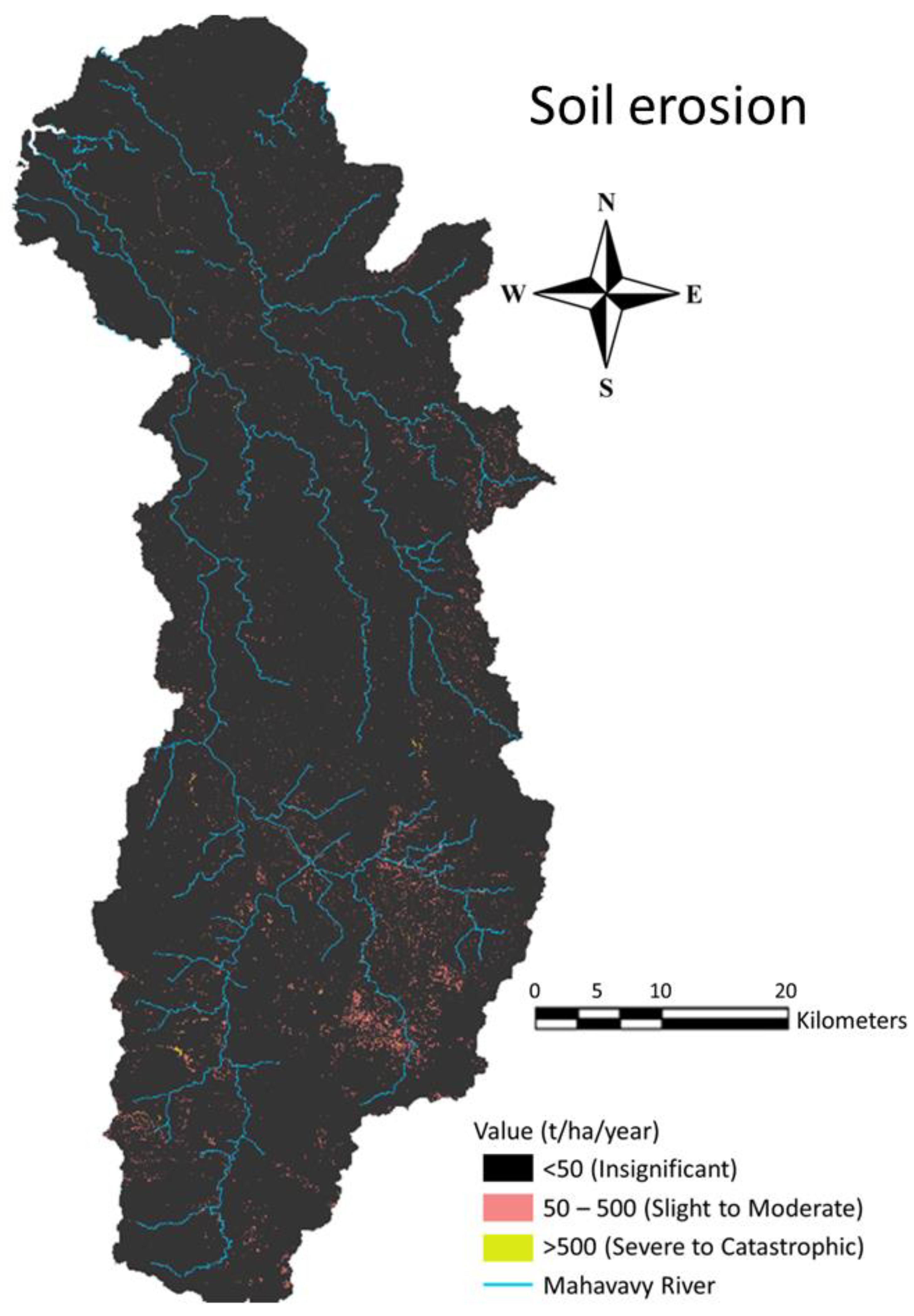
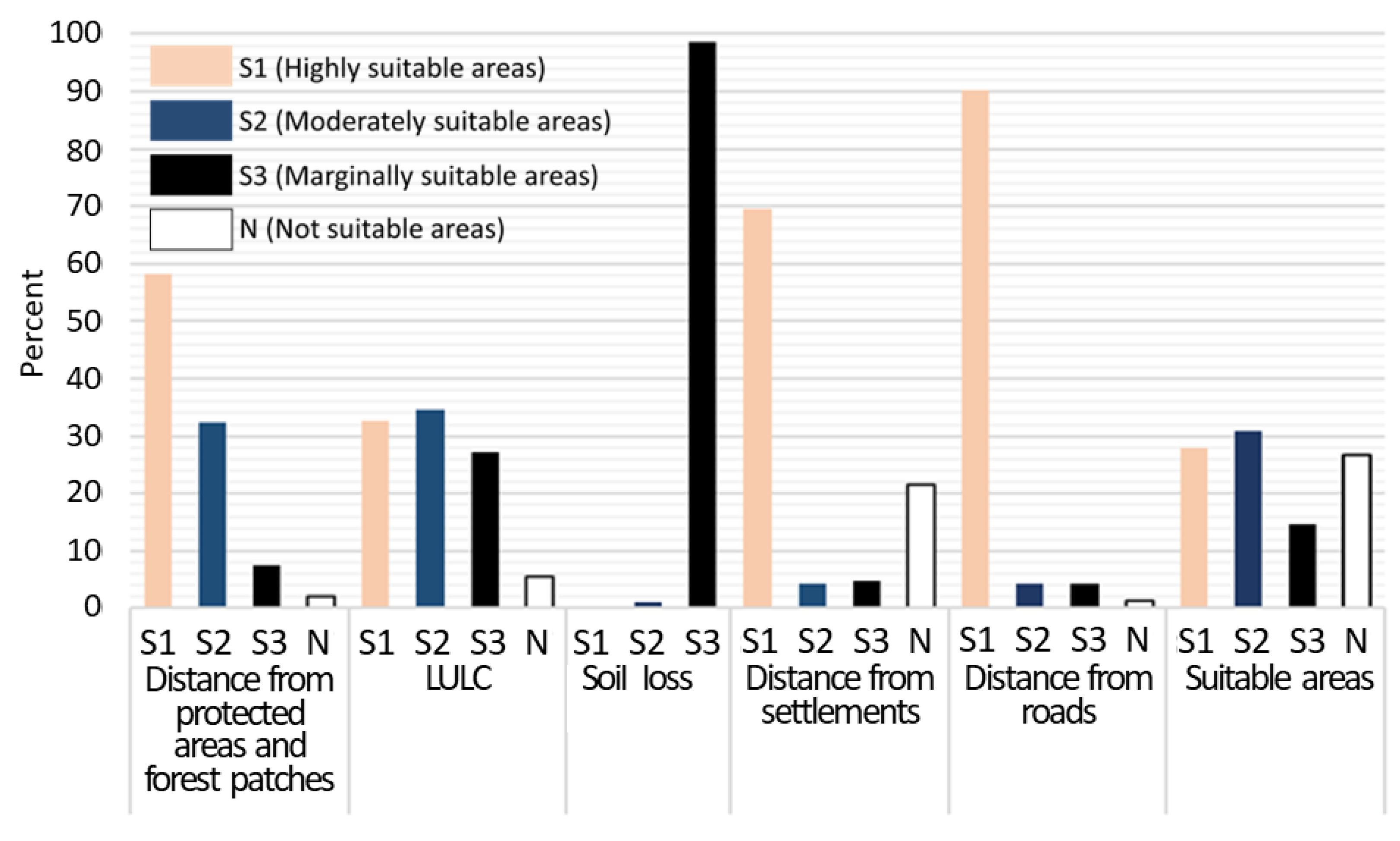
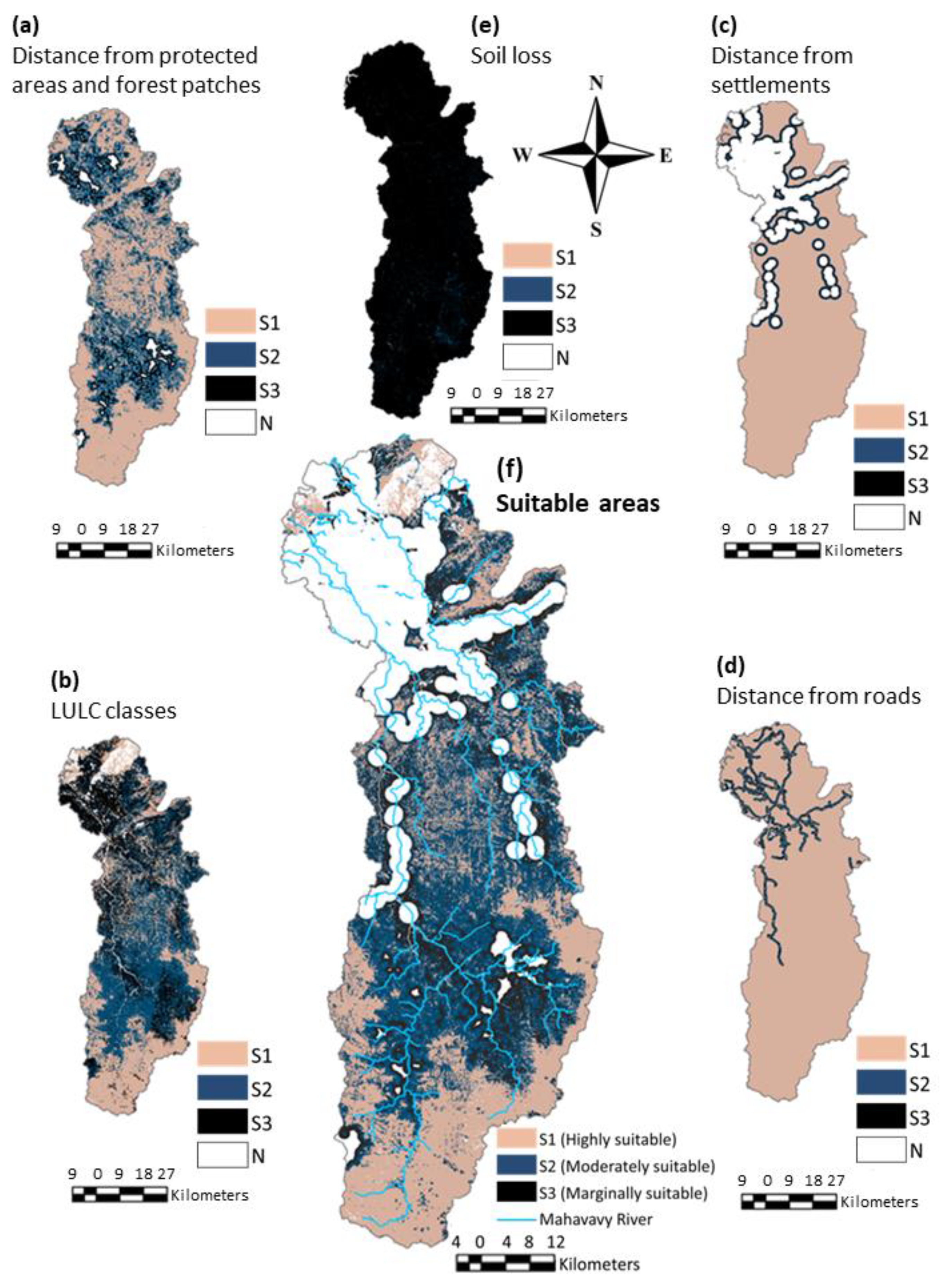
| No. | Criteria | Scale/Resolution | Data Source |
|---|---|---|---|
| 1 | Land use/Land cover | 30 m resolution | 2021, Landsat 8 OLI |
| 2 | Ambilobe District boundary Mahavavy Watershed boundary | 1:13,300,000 | Dataset- Humanitarian Data Exchange https://data.humdata.org. (Last accessed 19 October 2022) |
| 3 | Settlement | 30 m resolution | Landsat 8, Google Earth |
| 4 | Roads | 1:1,300,000 | Madagascar—Geofabrik Download Server https://download.geofabrik.de/africa/madagascar.html (Last accessed 19 October 2022 ) |
| 5 | Soil erosion | 1:1,300,000 | Elevation data using ASTER Global Digital Elevation Model (GDEM) from Earthdata.nasa.gov Global Soil Data from FAO Database https://data.apps.fao.org/map/catalog/srv/eng/catalog.search#/metadata/446ed430-8383-11db-b9b2-000d939bc5d8 (last accessed 19 October 2022) Rainfall Data 1901–2021 from CRU Database https://crudata.uea.ac.uk/cru/data/hrg/ (Last accessed 19 October 2022) |
| The C Factor | The P Factor | ||
|---|---|---|---|
| Land Use/Land Cover Class | C Factor | Slope (%) | Contouring |
| Dense forest | 0.0015 | 0.0–7.0 | 0.55 |
| Degraded forest | 0.0200 | 7.0–11.3 | 0.60 |
| Agriculture land | 0.4000 | 11.3–17.6 | 0.80 |
| Water | 0.0000 | 17.6–26.8 | 0.90 |
| Rock | 0.0000 | >26.8 | 1.00 |
| Grassland | 0.0150 | ||
| Weight | ||||
|---|---|---|---|---|
| Ecological Factors | Socio-Economic Factors | |||
| Distance from protected areas and forest patches | LULC | Soil loss | Distance from settlements | Distance from roads |
| 0.25 | 0.25 | 0.16 | 0.17 | 0.17 |
| Total weight: 0.50 | Total weight: 0.50 | |||
| LULC Classification | Accuracy Assessment (%) | |||
|---|---|---|---|---|
| Producer’s Accuracy | User’s Accuracy | Overall Accuracy | Kappa Coefficient | |
| Dense forest | 91.67 | 94.28 | 87.1 | 0.85 |
| Degraded forest | 76.19 | 91.42 | ||
| Grassland | 72.09 | 88.57 | ||
| Agriculture land | 93.54 | 85.29 | ||
| Waterbody | 100 | 96 | ||
| Bare land | 100 | 71.43 | ||
| Rock | 100 | 81.81 | ||
Publisher’s Note: MDPI stays neutral with regard to jurisdictional claims in published maps and institutional affiliations. |
© 2022 by the authors. Licensee MDPI, Basel, Switzerland. This article is an open access article distributed under the terms and conditions of the Creative Commons Attribution (CC BY) license (https://creativecommons.org/licenses/by/4.0/).
Share and Cite
Rajaonarivelo, F.; Williams, R.A. Remote Sensing-Based Land Suitability Analysis for Forest Restoration in Madagascar. Forests 2022, 13, 1727. https://doi.org/10.3390/f13101727
Rajaonarivelo F, Williams RA. Remote Sensing-Based Land Suitability Analysis for Forest Restoration in Madagascar. Forests. 2022; 13(10):1727. https://doi.org/10.3390/f13101727
Chicago/Turabian StyleRajaonarivelo, Fitiavana, and Roger A. Williams. 2022. "Remote Sensing-Based Land Suitability Analysis for Forest Restoration in Madagascar" Forests 13, no. 10: 1727. https://doi.org/10.3390/f13101727
APA StyleRajaonarivelo, F., & Williams, R. A. (2022). Remote Sensing-Based Land Suitability Analysis for Forest Restoration in Madagascar. Forests, 13(10), 1727. https://doi.org/10.3390/f13101727







